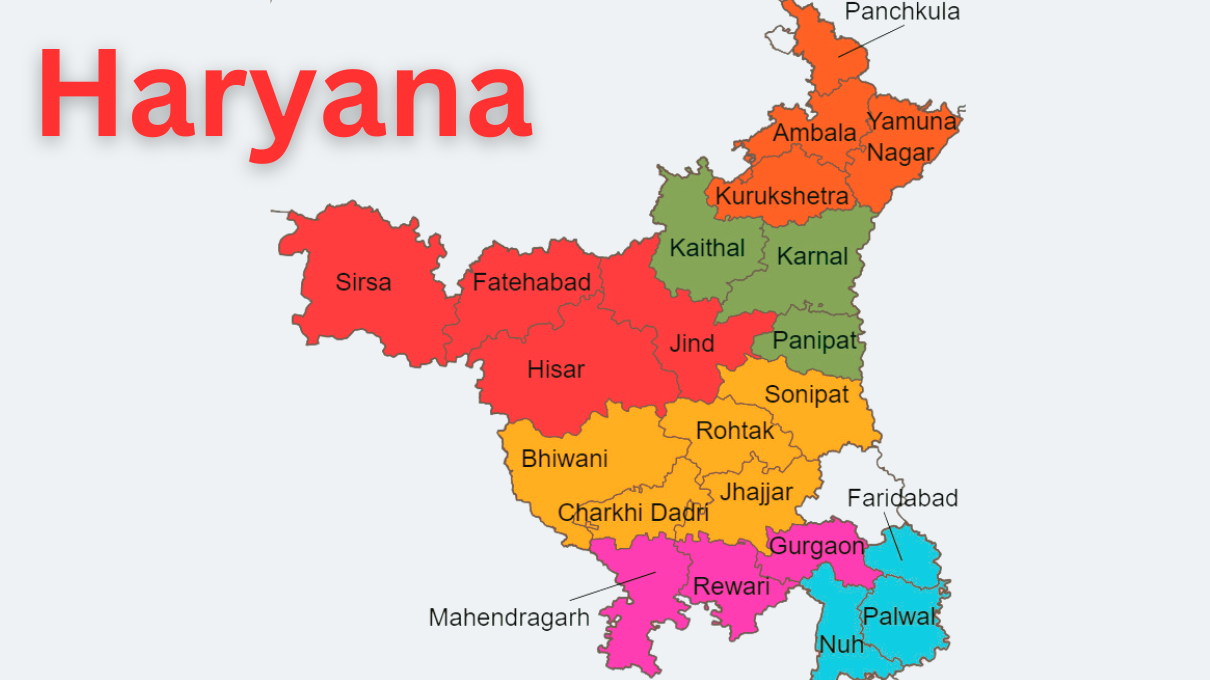Haryana
Haryana is a northern Indian state celebrated for its significant contributions to India’s economy, history, and cultural heritage. Officially formed on 1 November 1966, following the linguistic reorganization of Punjab, Haryana is a relatively small state geographically, ranking 21st in size, with an area covering just 1.4% of India’s total landmass (44,212 km² or 17,070 sq mi). Despite its modest size, Haryana plays a pivotal role in India’s industrial, agricultural, and technological development.
The capital city, Chandigarh, is shared with Punjab, serving as a hub for administrative activities. Haryana’s most populous city, Faridabad, lies within the National Capital Region (NCR), which surrounds Delhi. Another significant city, Gurgaon, is recognized as one of India’s foremost financial and technology hubs, housing numerous multinational corporations and startups. The state’s administrative structure includes 6 divisions, 22 districts, 72 subdivisions, and over 7,000 villages, reflecting its robust governance framework.
Haryana’s economy is among the strongest in India, ranking as the 13th largest state economy. The state’s Gross State Domestic Product (GSDP) stands at an impressive ₹7.65 trillion (US$92 billion), with a per capita GSDP of ₹240,000 (US$2,900), placing it 5th among Indian states.
Haryana: Economic Powerhouse, Cultural Heritage
The state is home to 32 Special Economic Zones (SEZs), strategically situated within the industrial corridors of the NCR. These SEZs, particularly in cities like Gurgaon and Faridabad, foster the growth of information technology, manufacturing, and automobile industries. Gurgaon, in particular, has become synonymous with technological and industrial innovation, hosting global corporations and contributing significantly to employment generation.
Haryana’s economy is also rooted in agriculture, earning it the title of the “breadbasket of India.” The state is a leading producer of wheat, rice, and milk, which not only sustains its economy but also supports the nation’s food security.
Haryana’s cultural and historical legacy is profound, making it a significant region in India’s historical narrative. It is believed that the state was named after the Ābhiras, an ancient community that lived here during the post-Mahabharata period and were known for their expertise in agriculture. Over time, the name evolved from Ābhirāyana (the land of the Ābhiras) to Ahirāyana and eventually to Hariyānā, meaning the “Abode of God.”
Haryana is also known for its connection to the epic Mahabharata, with Kurukshetra, the site of the legendary war, located within the state. The region is dotted with ancient monuments, archaeological sites, and pilgrimage centers, showcasing its historical depth and cultural vibrancy.
Ancient Period
Indus Valley Civilization
- Haryana is home to significant sites of the Indus Valley Civilization, particularly Rakhigarhi (Hisar district) and Bhirrana (Fatehabad district).
- Rakhigarhi is one of the largest known Harappan sites, showcasing advanced urban planning, including paved roads, a drainage system, and a large-scale rainwater storage system.
- Archaeological findings include terracotta bricks, tools, and statues, reflecting skilled craftsmanship and knowledge of metallurgy involving both bronze and precious metals.
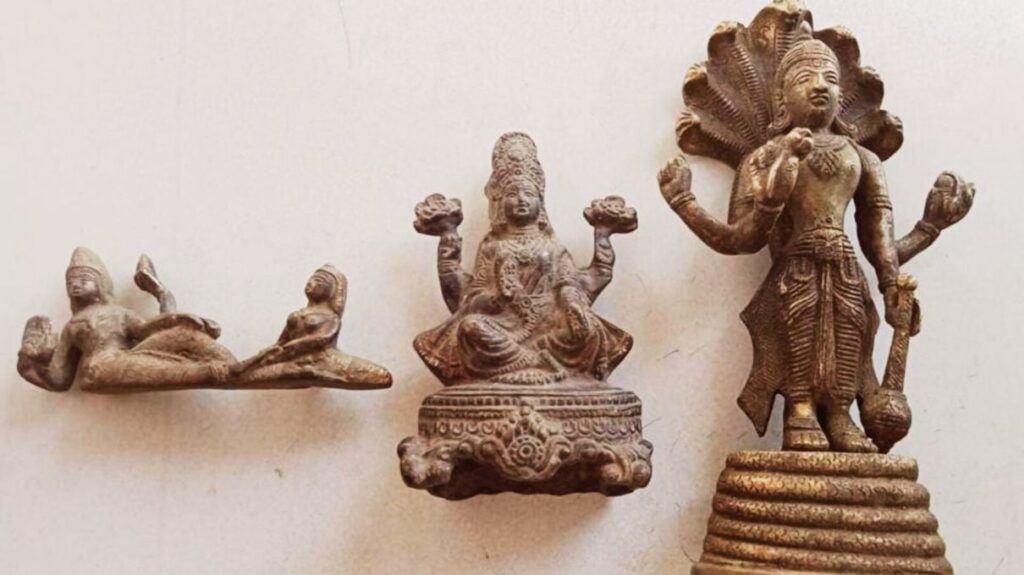
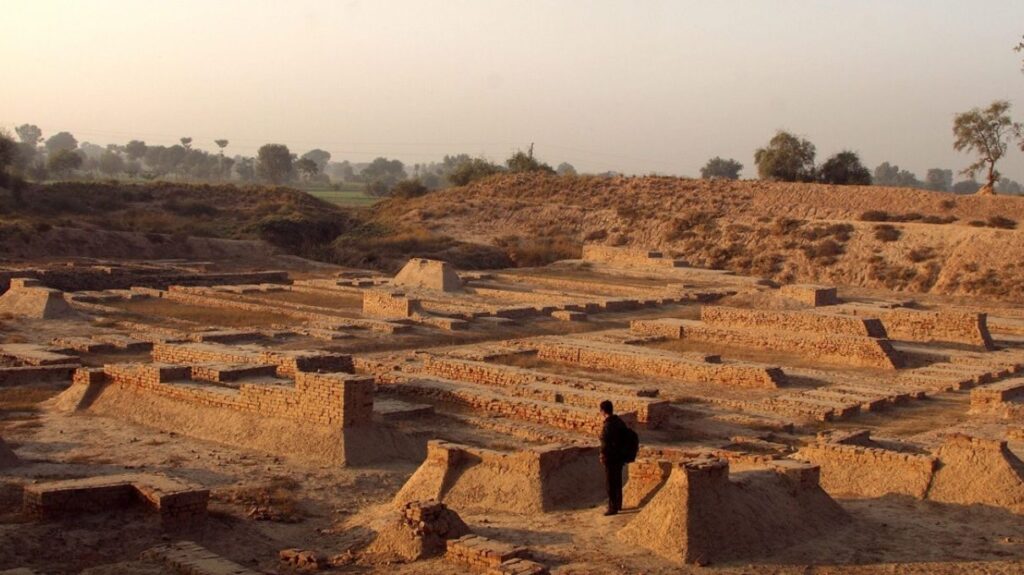
Vedic Civilization
- During the Vedic era, Haryana was the center of the Kuru Kingdom, one of India’s renowned Mahajanapadas.
- The Manusmriti refers to this region as Brahmavarta, the sacred land where the earliest Vedic texts were composed.
- Located in the southern part of Haryana, Brahmavarta was bordered by the Sarasvati and Drishadwati rivers, marking it as a cradle of Sanatan-Vedic (Hindu) ethos.
- Dhosi Hill, situated near Rewari and Mahendragarh, housed ashrams of sages (Rishis) like Chyavana, contributing to the creation of foundational Hindu scriptures, including the Vedas, Upanishads, and Puranas.
Medieval Period
Pushya Bhuti Dynasty
- Haryana played a crucial role in early medieval India as the seat of the Pushyabhuti dynasty, which ruled northern India in the 7th century.
- Thanesar, near present-day Kurukshetra, was the capital of the dynasty.
- Harsha, the most prominent ruler of the dynasty, expanded the kingdom and was celebrated for his patronage of arts and culture.
Tomara Dynasty
- The southern region of Haryana came under the rule of the Tomara dynasty during the 10th century.
- Anangpal Tomar, a noted ruler of the dynasty, strengthened the region’s governance and defense.
Timurid Invasions (1398)
- Timur’s conquests were a period of immense turmoil in Haryana’s history.
- Timur invaded Haryana, sacking cities such as Sirsa, Fatehabad, and Panipat.
- Residents fled or were massacred, with thousands enslaved. Villages were destroyed, and property was looted extensively.
Hemu (Hem Chandra Vikramaditya)
- Hemu, a Hindu ruler from Rewari, emerged as a powerful figure during the 16th century.
- He defeated Akbar’s Mughal forces in the Battle of Delhi (1556) and assumed the ancient title of Vikramaditya after a formal coronation at Purana Qila in Delhi.
- Hemu’s reign was short-lived as he was defeated and killed in the Second Battle of Panipat (1556).
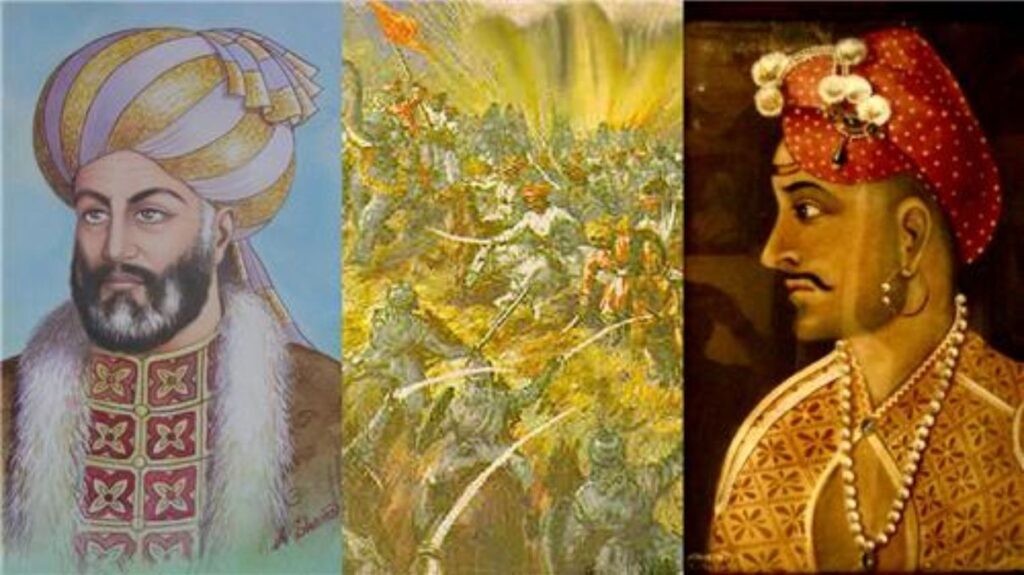
Battles of Panipat
Haryana’s city of Panipat is historically significant for three pivotal battles that shaped Indian history:
- First Battle of Panipat (1526): Babur defeated Ibrahim Lodi, marking the foundation of the Mughal Empire in India.
- Second Battle of Panipat (1556): Akbar defeated Hemu, securing Mughal rule in northern India.
- Third Battle of Panipat (1761): Ahmad Shah Abdali defeated the Marathas, weakening their influence in northern India.
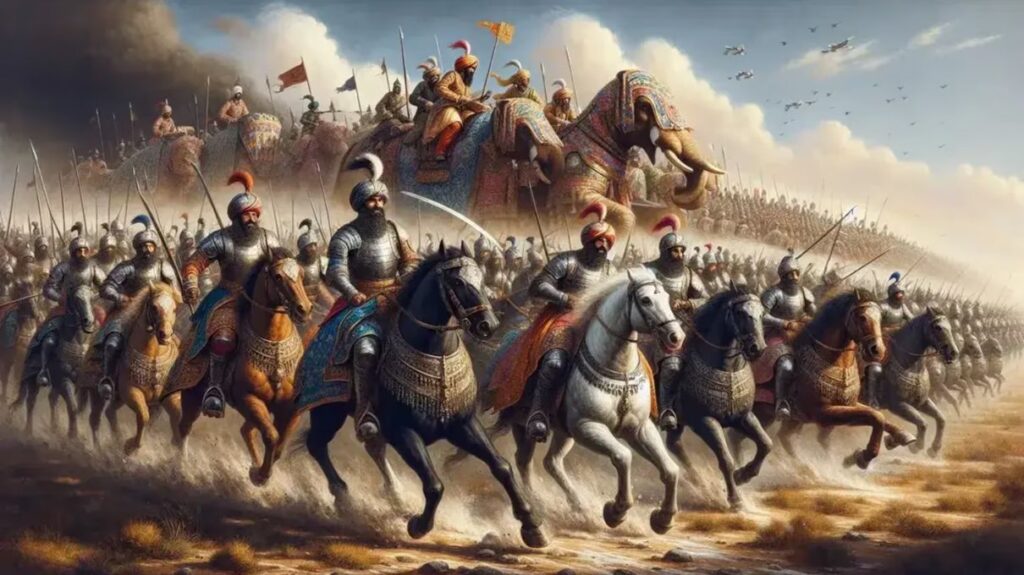
British Period
British Punjab Province
- Haryana was part of the Delhi division of British Punjab province.
- Several princely states, including Jind, Kalsia, Loharu, and Pataudi, were located within Haryana.
Partition of India (1947)
- The partition of Punjab during India’s independence led to the division of the province into East Punjab (India) and West Punjab (Pakistan).
- Haryana became part of East Punjab, with a large influx of Hindu and Sikh refugees from West Punjab.
- Muslims in Haryana migrated to Pakistan, creating significant demographic shifts.
Formation of Haryana (1966)
Punjab Reorganisation Act (1966)
- Haryana was carved out of Punjab on 1 November 1966 following the linguistic reorganization of states.
- The Shah Commission, chaired by Justice J.C. Shah, was tasked with defining the new state’s boundaries based on language demographics.
- Predominantly Hindi-speaking regions, including Hisar, Mahendragarh, Gurgaon, Rohtak, and Karnal, were included in Haryana.
- Chandigarh was designated as a Union Territory, serving as the joint capital of Punjab and Haryana.
Leadership and Advocacy
- Bhagwat Dayal Sharma became Haryana’s first Chief Minister.
- Chaudhary Devi Lal was a key figure in advocating for the state’s creation, earning recognition for his contributions to Haryana’s formation.

Historical Population Growth
Haryana’s population trends show steady growth, with varying annual rates.
| Year | Population | Growth Rate (%) |
|---|---|---|
| 1881 | 4,015,386 | — |
| 1901 | 4,268,222 | +0.31% |
| 1911 | 3,870,574 | -0.97% |
| 1921 | 4,211,393 | +0.85% |
| 1931 | 4,495,730 | +0.66% |
| 1941 | 5,166,169 | +1.40% |
| 1951 | 5,673,597 | +0.94% |
| 1961 | 7,590,524 | +2.95% |
| 1971 | 10,036,431 | +2.83% |
| 1981 | 12,922,119 | +2.56% |
| 1991 | 16,463,648 | +2.45% |
| 2001 | 21,144,564 | +2.53% |
| 2011 | 25,351,462 | +1.83% |
- Haryana witnessed rapid growth between 1961–1991, primarily due to improved healthcare, agricultural advancements, and industrial development.
- A gradual decline in growth rates since 2001 aligns with broader national trends of urbanization and family planning initiatives.
Top 5 Cities in Haryana
1.Chandigarh
2. Faridabad
3. Gurgaon
4. Panipat
5. Rohtak
Caste and Community Composition
Haryana’s population comprises a blend of castes and tribes, reflecting its rural and semi-urban character.
Caste-Wise Distribution (2019 Estimates):
- Jats: 25–27% (Dominant community, mainly involved in agriculture)
- Scheduled Castes: 21%
- Punjabis: 8% (primarily concentrated in northeastern regions)
- Brahmins: 7.5%
- Ahir/Yadav: 5.1%
- Vaish: 5% (Business community)
- Jat Sikhs: 4%
- Muslims (including Meos): 3.8%
- Rajputs: 3.4%
- Gujjars: 3.4%
- Sainis: 2.9%
- Kumhars: 2.7%
- Ror: 1.1%
- Bishnois: 0.7%
Linguistic Diversity
Haryana is a linguistically rich state with a mix of official and regional languages.
Language Statistics (2011 Census):
| Language | Percentage |
|---|---|
| Hindi | 47.96% |
| Haryanvi | 37.17% |
| Punjabi | 7.36% |
| Bagri | 2.11% |
| Mewati | 1.66% |
| Urdu | 1.48% |
| Baghati | 1.28% |
- Official Language: Hindi
- Second Official Language: Punjabi (recognized in 2010)
- Regional Dialects:
- Haryanvi (Bangru): Predominant in central and eastern parts.
- Bagri: Spoken in the western regions.
- Ahirwati, Mewati, and Braj Bhasha: Common in the southern areas.
- Deshwali: Used in eastern Haryana.
Historically, Tamil was designated the “second language” in 1969 for political reasons but was later removed in 2010 due to a lack of speakers.
Religious Composition
Haryana is predominantly Hindu, with notable minorities of Muslims and Sikhs.
Religion-Wise Distribution (2011 Census):
| Religion | Percentage | Population |
|---|---|---|
| Hinduism | 87.46% | 22,171,128 |
| Islam | 7.03% | 1,781,342 |
| Sikhism | 4.91% | 1,243,752 |
| Jainism | 0.21% | 52,613 |
| Christianity | 0.20% | 50,353 |
| Buddhism | 0.03% | 7,514 |
| Others | 0.18% | 44,760 |
- Hindu Majority: Most Hindus are concentrated across all districts, forming the state’s cultural and religious backbone.
- Muslims: Found predominantly in the Nuh district, with a significant presence of the Meo Muslim community.
- Sikhs: Haryana has the second-largest Sikh population in India after Punjab, primarily in districts adjacent to Punjab, such as Sirsa, Jind, and Ambala.
Historical Religious Trends
The region’s religious demographics have shifted significantly since the 19th century.
| Year | Hinduism (%) | Islam (%) | Sikhism (%) | Jainism (%) | Christianity (%) | Others (%) |
|---|---|---|---|---|---|---|
| 1881 | 71.31 | 25.14 | 2.95 | 0.50 | 0.10 | 0.00 |
| 1901 | 70.57 | 25.54 | 3.18 | 0.56 | 0.15 | 0.00 |
| 1941 | 66.52 | 27.13 | 5.66 | 0.45 | 0.22 | 0.01 |
| 2011 | 87.46 | 7.03 | 4.91 | 0.21 | 0.20 | 0.18 |
- The decline in Islam’s share post-Partition (1947) is due to migration to Pakistan, while Hinduism saw an increase.
- Sikhism has grown consistently since the 19th century.
Music of Haryana
Haryana’s music is a vibrant expression of its cultural roots, blending tradition with a distinct regional flair. It includes both classical folk music and desi folk music, reflecting themes of valor, love, celebration, and spirituality. Classical folk music is deeply influenced by Hindustani classical ragas, such as Raag Bhairavi and Raag Kafi, and is often performed during festivals like Holi and Teej. These songs are typically sung in high-pitched tones to emphasize heroic and devotional themes.
Desi folk music, on the other hand, is more community-driven and versatile. It celebrates relationships, festivities, and life events, often using a mix of seasonal and ceremonial themes. Songs like Phaag (spring songs) and Holi Geet are staples, while ballads recount tales of bravery or romantic sagas. Women play a significant role in desi music, performing everything from celebratory wedding songs to devotional Mangal Geet.
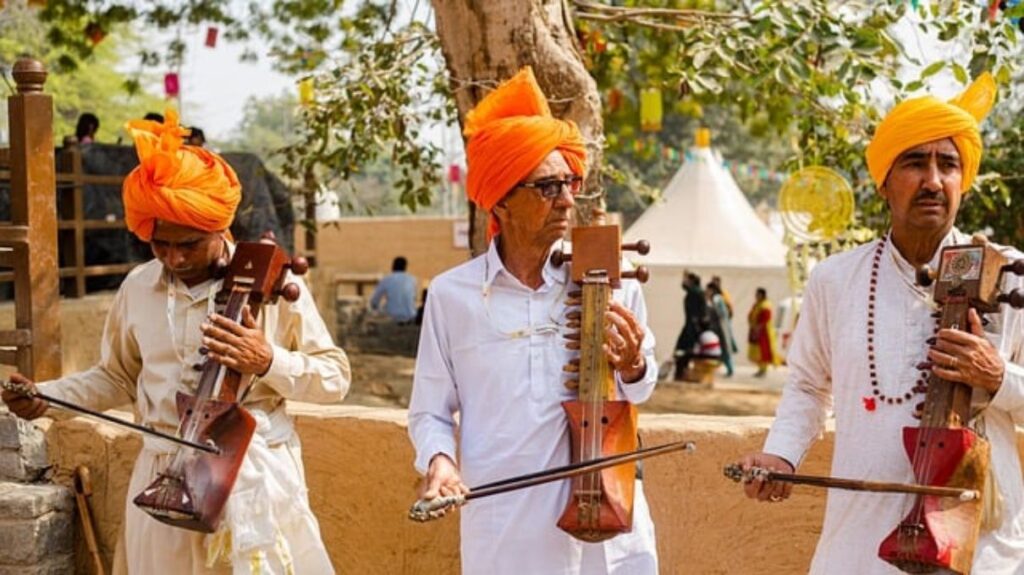
Folk music holds a special place in Haryanvi society as it transcends caste boundaries, bringing communities together during festivals, weddings, and special occasions. The adaptability of Haryanvi songs, including their integration with Bollywood tunes, ensures their relevance while retaining a distinct cultural identity.
Music in Haryana is not just an art form; it’s a unifying force fostering community cohesion.
Folk Dances of Haryana
The folk dances of Haryana are an integral part of the state’s cultural fabric, showcasing its agrarian and martial heritage. These dances are fast-paced, energetic, and celebratory, reflecting the robust spirit of Haryanvi people. They can be broadly classified into three categories: festive-seasonal, devotional, and ceremonial-recreational.
Festive-seasonal dances are performed during occasions like Teej, Holi, and Sawan. These dances often involve vibrant costumes and rhythmic movements, creating a joyous atmosphere. Devotional dances, like Chaupaiya and Ras Leela, are more spiritual in nature, narrating mythological tales and celebrating religious festivals.
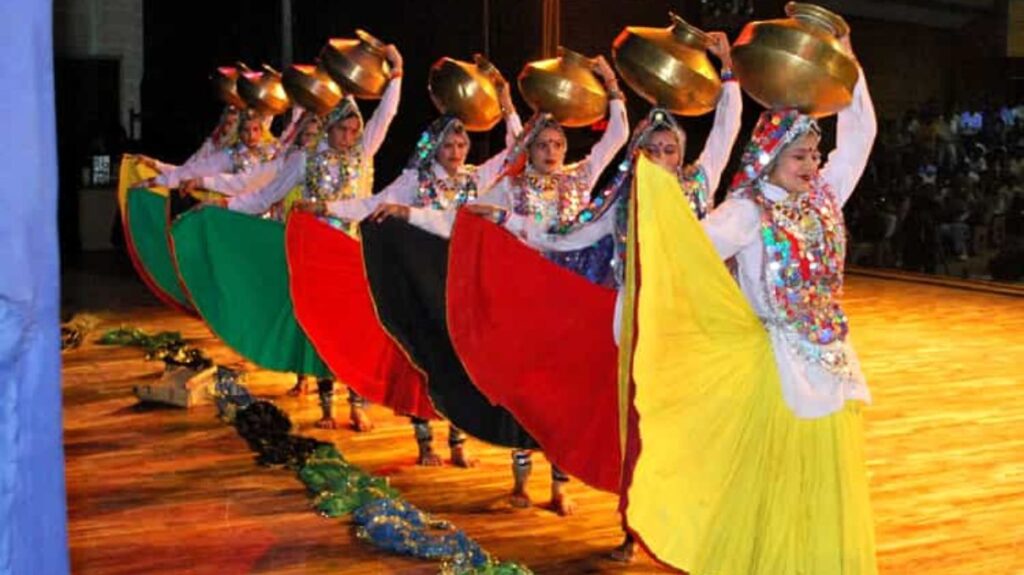
Ceremonial-recreational dances are performed during significant life events and communal gatherings. Iconic dances like Ghoomar and Dhamal Dance narrate tales of bravery, romance, and rituals. The Been Dance, often associated with snake charmers, is a unique highlight, captivating audiences with its synchronized movements and the melodious sound of the bean (flute).
These folk dances are more than entertainment; they foster unity among communities, breaking societal barriers of caste and status. By participating in these traditional forms of expression, Haryanvi people celebrate their cultural heritage and pass it on to future generations.
Cuisine of Haryana
Haryanvi cuisine is a reflection of its agrarian roots, characterized by simplicity, wholesomeness, and an abundance of dairy products. Known as the “Land of Rotis,” Haryana’s culinary traditions revolve around various types of flatbreads made from wheat, bajra, or a mix of grains like barley and gram. These are paired with seasonal vegetables, lentils, and saag, forming the backbone of a typical meal.
Dairy is a central element of Haryanvi cuisine. Fresh milk, butter, and ghee are staples in almost every household. Homemade butter, known as nooni or tindi ghee, is churned daily and generously used in cooking. Drinks like chaaj (buttermilk) and lassi are not only refreshing but also culturally significant. Lassi, a yogurt-based drink, is a favorite among locals, often consumed as a meal in itself during summer.
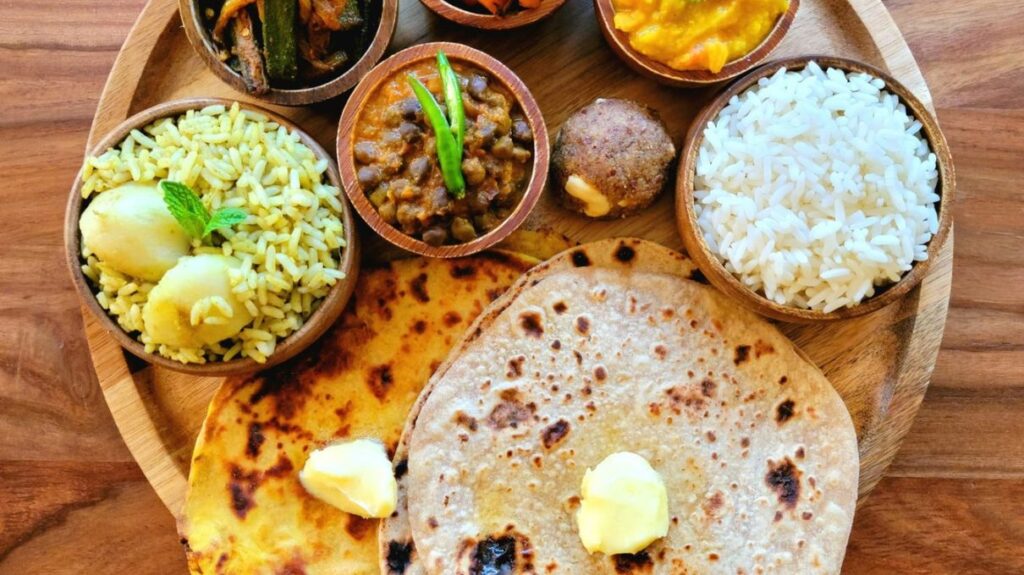
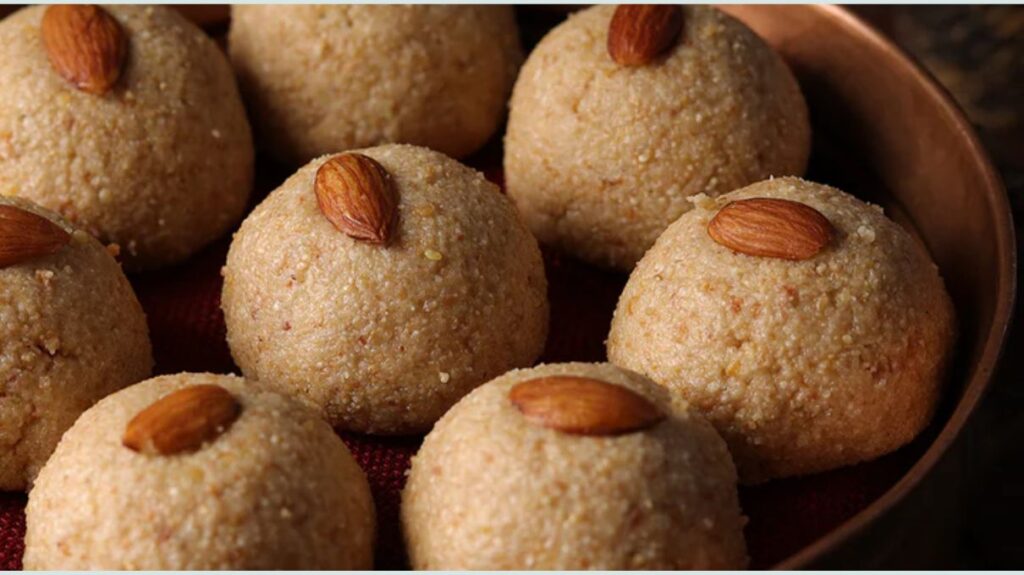
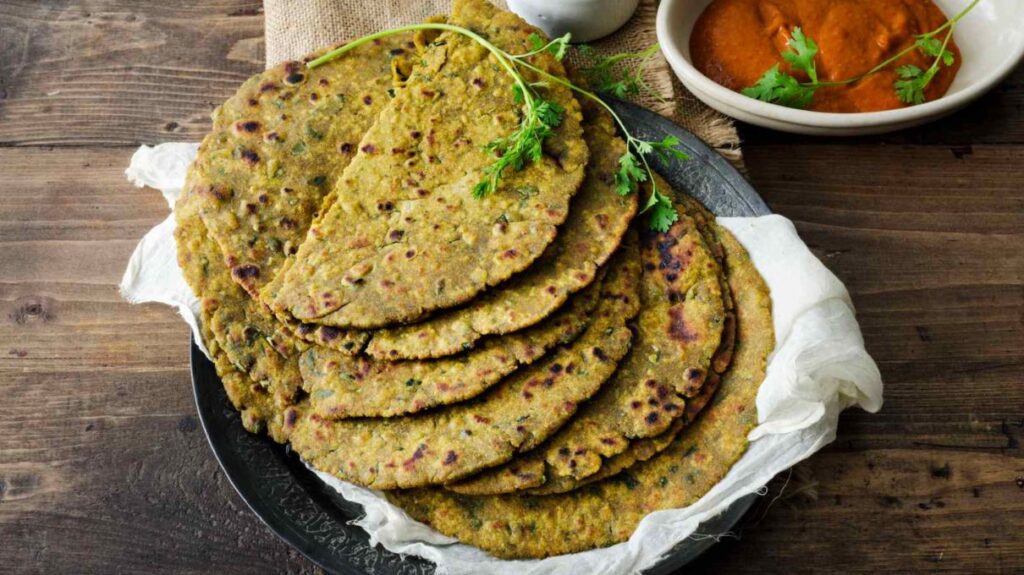
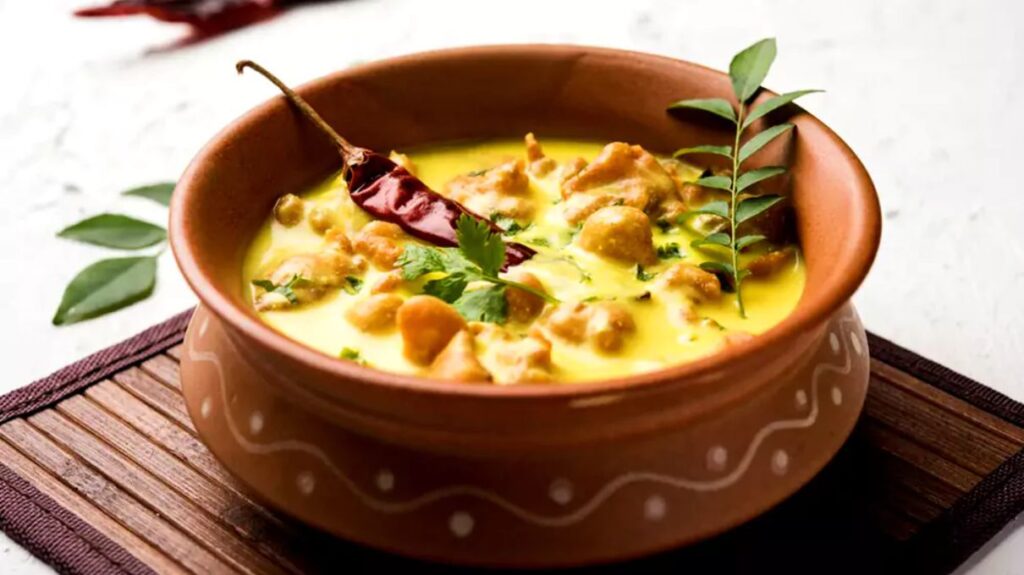
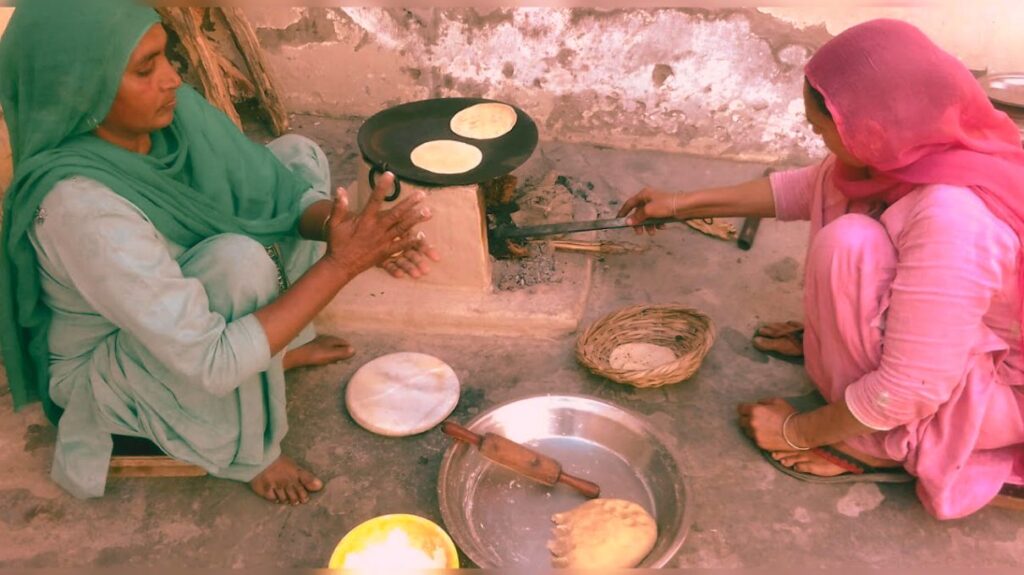
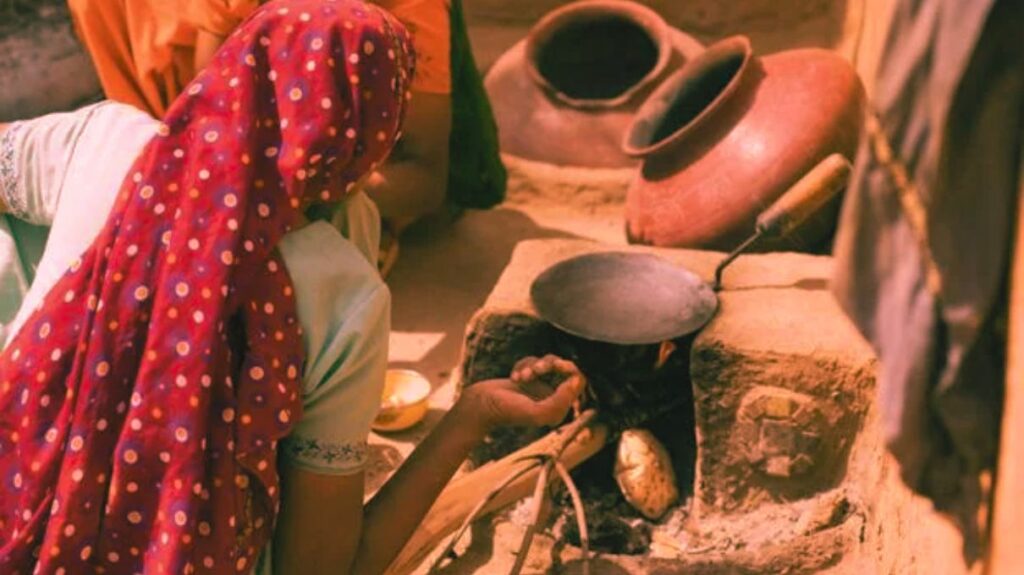
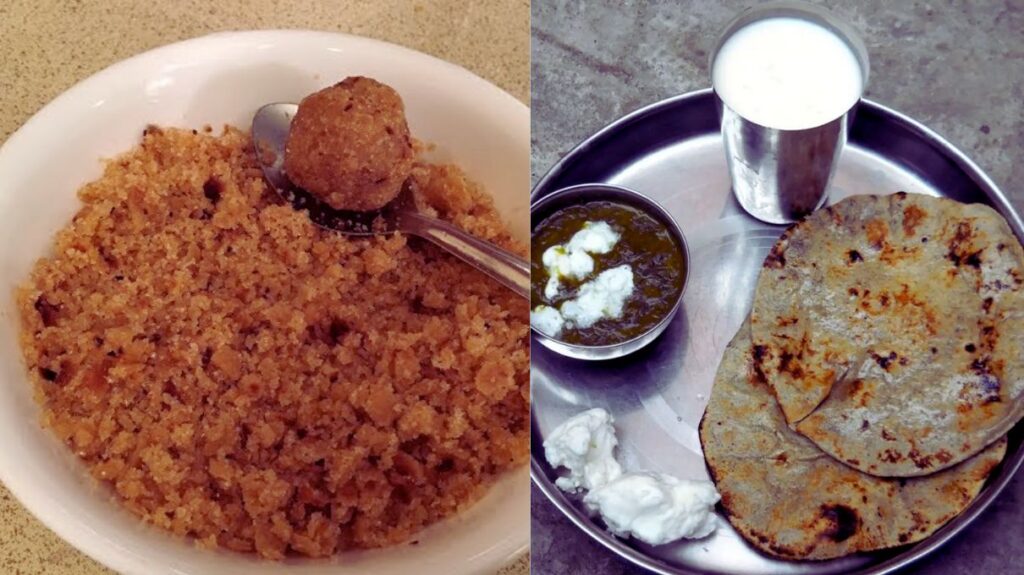
Special dishes include baajre ki roti, kheer, and laddus made from gram flour. During significant life events, such as a woman becoming a mother, families traditionally gift ghee, dry fruits, and laddus to symbolize nourishment and prosperity.
Haryanvi cuisine’s simplicity and emphasis on fresh, wholesome ingredients make it a true reflection of the state’s agricultural ethos and lifestyle.
Society and Inclusivity
Haryana’s society is built on the principle of inclusivity, famously symbolized by the “36 Jatas” or communities that coexist within the state. This concept represents the harmonious blending of various castes, such as Jats, Rajputs, Gurjaras, Ahirs, and Brahmins, emphasizing unity despite differences in social hierarchy.
Social structures in Haryana are deeply rooted in communal values, with music, dance, and rituals often serving as platforms for inter-caste interaction. Folk singers, irrespective of their caste, are highly respected and invited to perform at weddings, festivals, and other celebrations, breaking down societal barriers. Women play a pivotal role in preserving these cultural traditions, often singing together in groups, which fosters camaraderie and mutual respect among different strata.

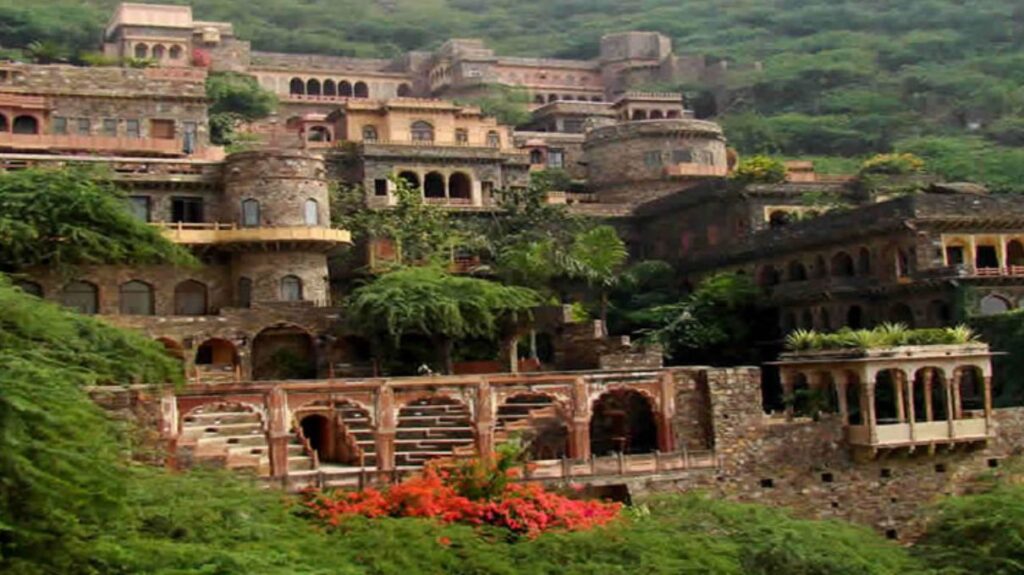
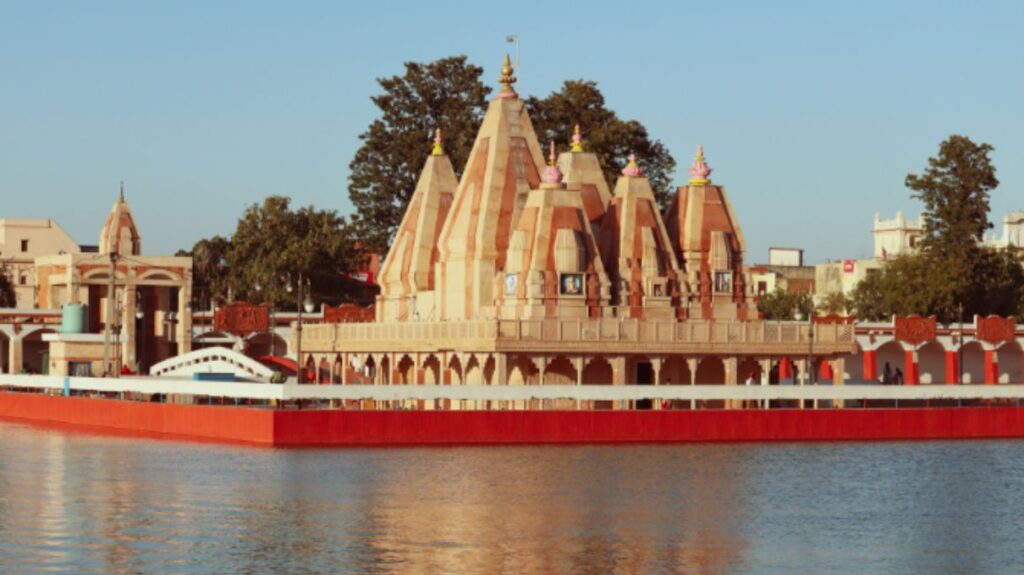
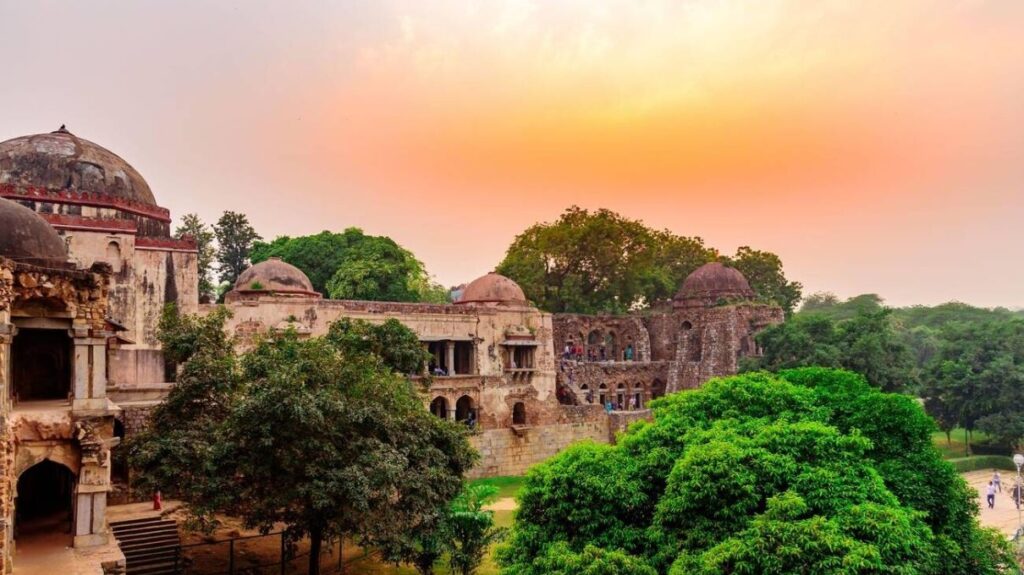
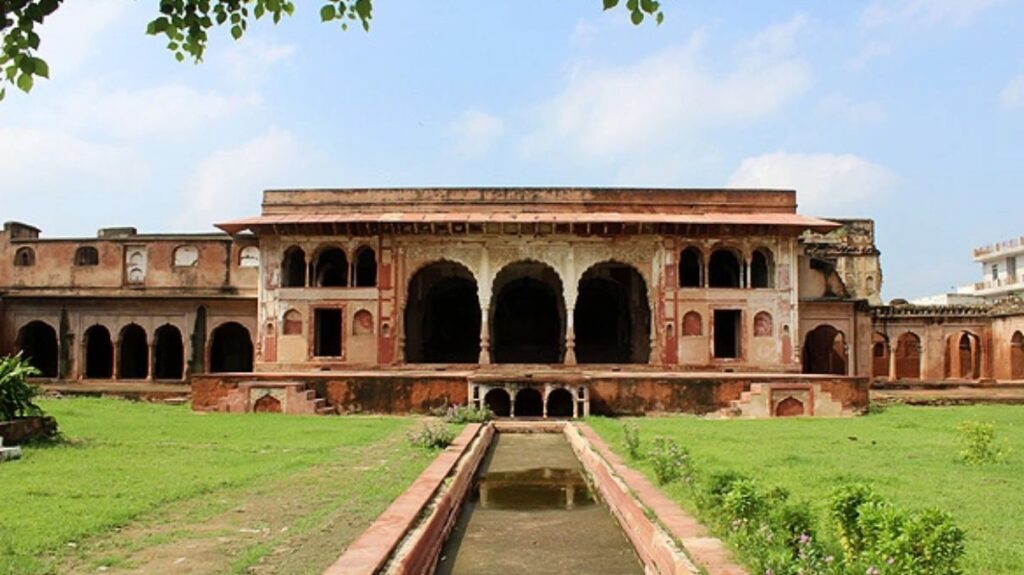
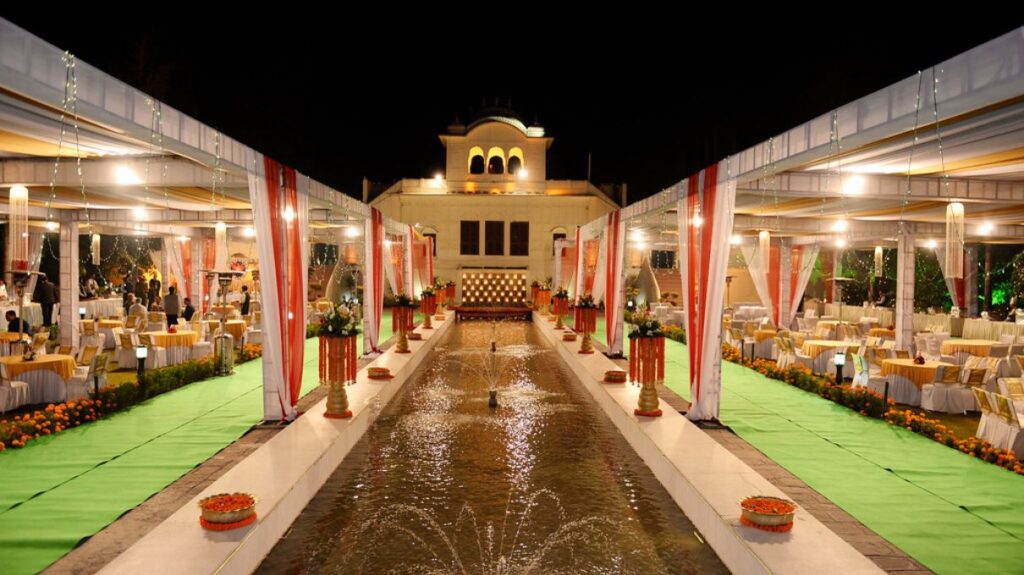
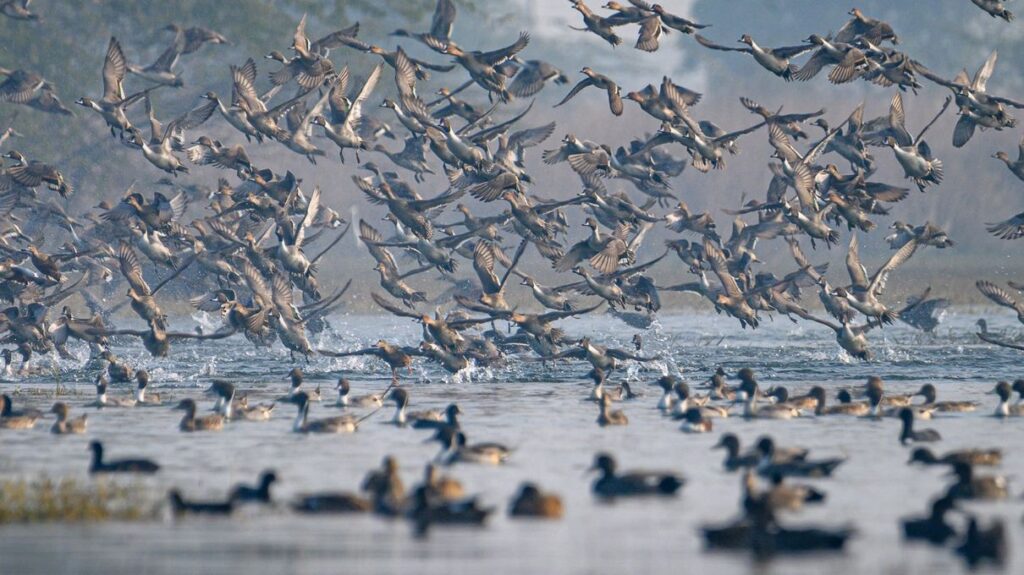
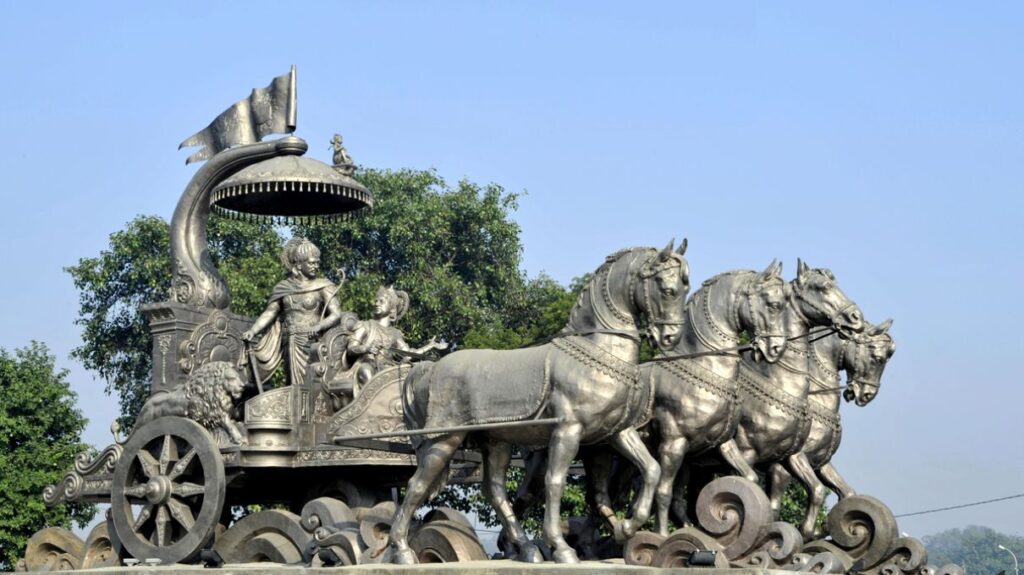
The emergence of urban centers like Gurgaon has further diversified Haryana’s social fabric. Public art initiatives, such as murals and graffiti, reflect a modern perspective while celebrating the state’s cultural heritage. These artworks often depict themes of unity, progress, and tradition, resonating with both rural and urban populations.
Haryana’s societal framework exemplifies the coexistence of tradition and modernity, creating a cohesive community that values its heritage while embracing progress. This inclusive spirit continues to shape the state’s identity in a rapidly changing world.
Geographical of Haryana
Haryana, situated in northern India, is a landlocked state known for its strategic location and agricultural significance. It lies between 27°39′ to 30°35′ N latitude and 74°28′ to 77°36′ E longitude, covering an area of 44,212 square kilometers. Despite its small size, Haryana holds immense economic and cultural value due to its proximity to Delhi, India’s capital, and Chandigarh, its shared capital with Punjab.
Haryana’s topography is diverse, ranging from fertile plains to semi-arid regions. The altitudes in the state range from 700 feet to 3,600 feet above sea level, which contributes to its diverse climate and ecosystems. The state is largely dominated by plains, with areas like Ambala and Hisar being prime examples of flat, fertile land. However, the southern part of the state is slightly more rugged, transitioning into semi-arid zones.
Climate of Haryana
The climate of Haryana is primarily continental, characterized by extreme variations in temperature between summer and winter. Summers can be extremely hot, with temperatures soaring above 40°C in May and June, while winters are chilly, with temperatures dipping below 5°C in December and January. The state experiences monsoon rainfall, mostly between June and September, bringing much-needed moisture to its agricultural fields.
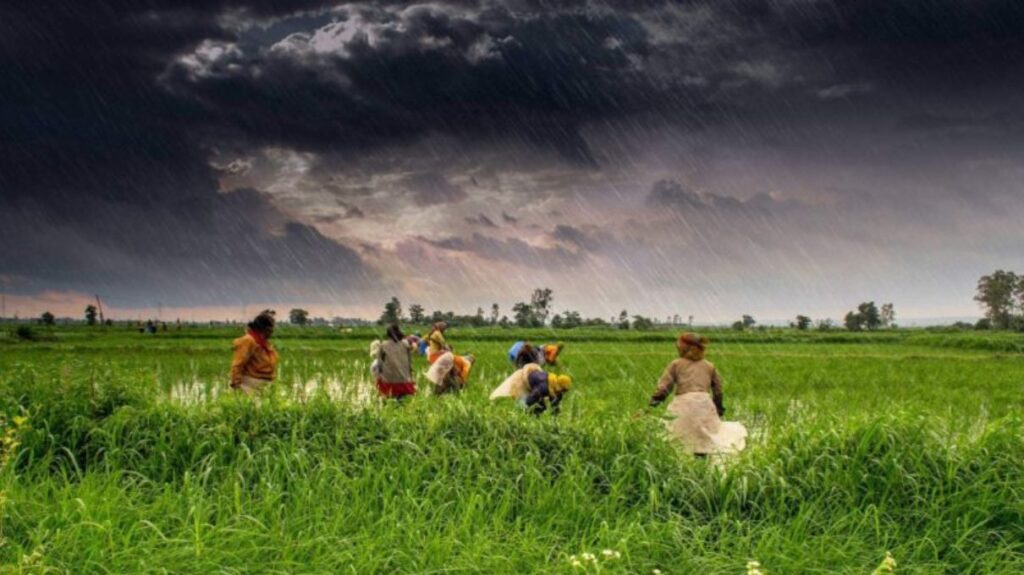
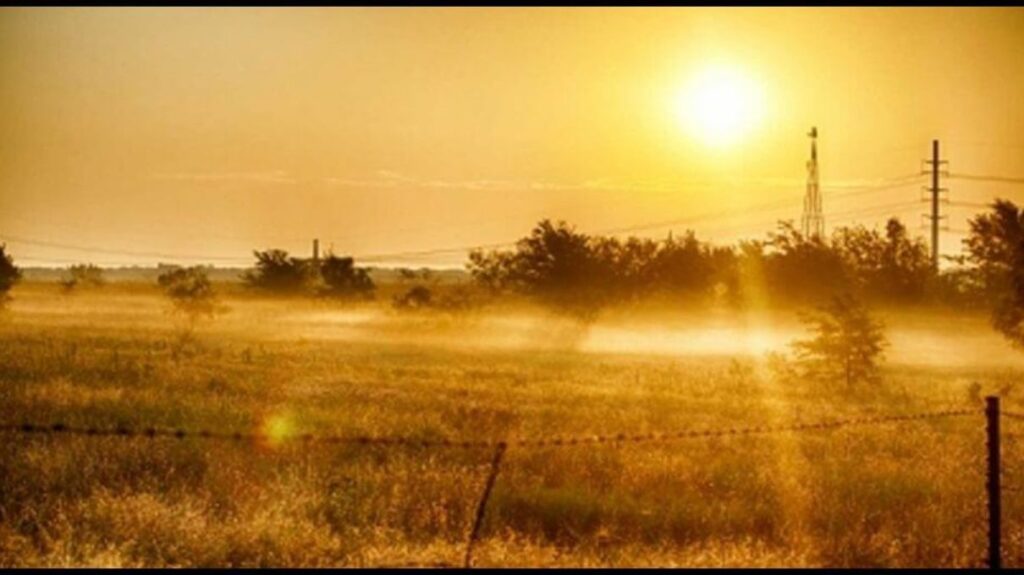
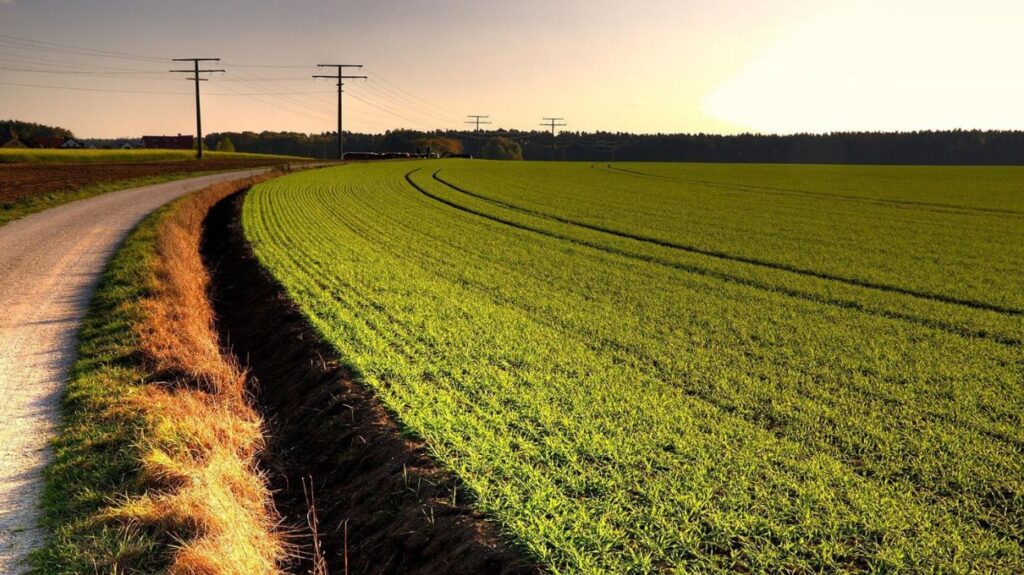
Humidity levels in the region are typically low, especially in the western districts, where dry conditions prevail for much of the year. As Haryana is part of the northwestern region of India, it occasionally experiences dust storms in the summer. The climate directly impacts Haryana’s agriculture, with crops like wheat, rice, and sugarcane being highly dependent on the monsoon rains.
Hydrography of Haryana
Haryana is drained by several important rivers, which play a pivotal role in irrigation, agriculture, and livelihood. The Yamuna River, which forms the eastern boundary of the state, is the primary source of water for Haryana. The state is also part of the Ganga Basin, making it strategically important for India’s agricultural output.
The Sarasvati River, though now largely dry, holds historical and cultural significance in the region. Besides the Yamuna, several other smaller rivers like the Ghaggar, Markanda, and Sohna provide water to the arid and semi-arid zones of Haryana. The presence of the Indira Gandhi Canal has greatly contributed to the irrigation of areas like Sirsa and Hisar.
Haryana’s water resources are heavily relied upon for its agriculture, which is the state’s backbone. However, with the growing population and the increasing demand for water, concerns around water scarcity and groundwater depletion have emerged. The state has initiated various water-conservation projects, including the revival of traditional water bodies and the expansion of the Bhakra Nangal Dam irrigation system.
Flora and Fauna of Haryana
The flora and fauna of Haryana are directly influenced by its climate and topography. While the state’s forest cover is limited, constituting only about 4% of its total area, the biodiversity found here is rich. Haryana is home to several national parks and wildlife sanctuaries like Sultanpur National Park and Kalesar National Park, which are known for their variety of birds and mammals.
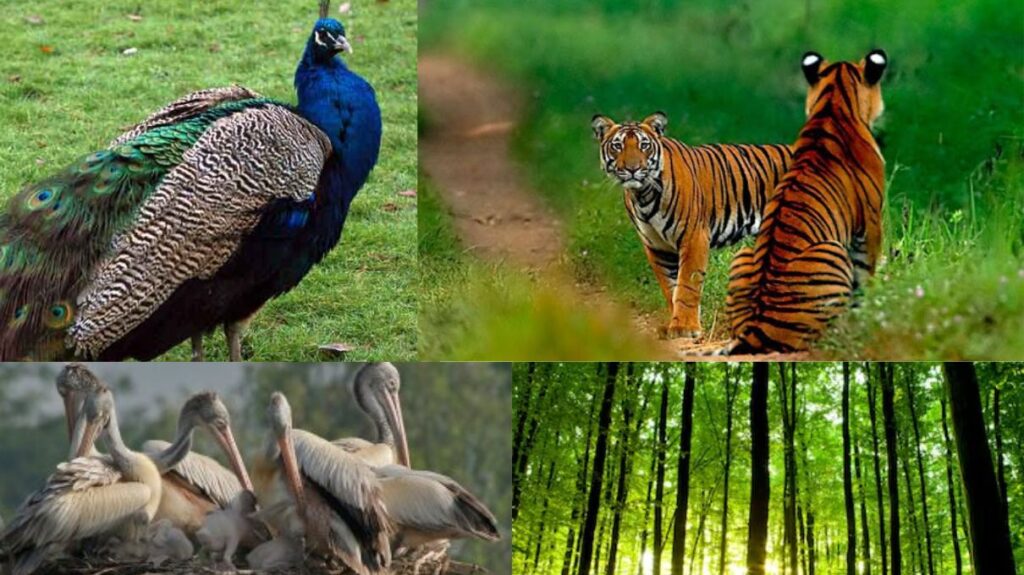
Haryana’s vegetation is predominantly made up of tropical dry deciduous forests, with species like khair, bamboo, safed siris, and ber trees. The state’s forests are crucial for preserving the balance of the ecosystem and maintaining soil fertility.
Regarding fauna, Haryana supports a range of species such as the Indian grey wolf, jackal, leopard, and various species of deer. The wetlands in areas like Sultanpur attract migratory birds, particularly during the winter months. The conservation of these species is critical, and Haryana is focused on ensuring that human-wildlife conflict is minimized.
Environmental Challenges
Haryana faces numerous environmental challenges due to its geographical and climatic conditions. Water scarcity is a pressing issue, as most of Haryana’s water supply is reliant on rivers like the Yamuna, which itself faces contamination. Moreover, the decline in groundwater levels is alarming, particularly in the southern and western districts, which depend heavily on underground aquifers for irrigation.
Soil degradation is another significant challenge. Excessive use of chemical fertilizers, coupled with the over-cultivation of certain crops, has led to soil erosion and nutrient depletion in various parts of the state. This, in turn, affects the long-term agricultural sustainability of Haryana.
Deforestation is also a concern, with urbanization and industrialization leading to the encroachment of forests and wildlife habitats. Efforts are underway to address these challenges through initiatives such as afforestation, water harvesting, and the promotion of sustainable farming practices.
Administration of Haryana
Haryana, a state in northern India, has a well-structured administrative setup that ensures efficient governance and service delivery. The state is divided into 6 revenue divisions: Ambala, Rohtak, Gurgaon, Hisar, Karnal, and Faridabad. Each division oversees multiple districts, and Haryana has a total of 22 districts, 72 sub-divisions, and 93 tehsils. There are 11 municipal corporations and several other municipalities, which are crucial for local governance and urban planning. The state’s administration is designed to ensure the smooth implementation of policies at both district and state levels.
Important cities in Haryana like Gurgaon, Faridabad, and Ambala are administrative hubs with advanced infrastructure, contributing significantly to the state’s economic and administrative landscape. The state’s local governance structure comprises village panchayats, municipal councils, and municipalities, which handle day-to-day governance tasks at the grassroots level.
Law and Order in Haryana
Maintaining law and order in Haryana is a responsibility of the Haryana Police, which operates through various police ranges such as Ambala, Hisar, Karnal, Rewari, and Rohtak. The state’s police force is well-equipped to handle all forms of crime, including cybercrime, with specialized units located in major cities like Gurgaon. There are four Police Commissionerates in the state—Faridabad, Gurgaon, Panchkula, and Sonipat—which help maintain law enforcement across urban areas.
The Punjab and Haryana High Court serves as the highest judicial authority for the state, with the Supreme Court of India being the appellate body. The judiciary ensures justice is delivered fairly, and the state has also implemented an e-filing system to make legal proceedings more accessible and efficient.
Governance and E-Governance in Haryana
Haryana is a pioneer in e-governance in India. The state has implemented various digital services through the Common Service Centres (CSCs), which offer citizens access to government services such as water and sanitation connections, electricity bill collection, and ration card applications. As part of the Digital India initiative, the state has integrated a single unified UMANG app that enables citizens to avail government services 24/7.
Haryana also became the first state to implement Aadhaar-enabled birth registration across all its districts, streamlining administrative processes. This initiative, along with the availability of online admission forms, examination results, and other public services, contributes significantly to enhancing government transparency and accessibility.
Economy of Haryana
Haryana’s economy is diverse and robust, with contributions from services, industries, and agriculture. As of the 2017-18 fiscal year, the state’s Gross State Domestic Product (GSDP) was estimated at USD 95 billion, with 52% of the economy driven by the services sector, which includes significant contributions from real estate, financial services, and IT services. Gurgaon, in particular, stands out as a hub for technology and startups, ranked first in India for its growth rate and technology infrastructure.
The industrial sector is equally strong, with Haryana producing over 67% of India’s passenger cars and 60% of motorcycles. The state has several Special Economic Zones (SEZs), which further boost its industrial growth, attracting both domestic and foreign investment.

Agriculture, though contributing a smaller percentage of the GSDP, remains a cornerstone of Haryana’s economy. The state accounts for 15% of India’s food grain production, making it crucial for the country’s food security.
Agriculture in Haryana
Agriculture is the backbone of Haryana’s economy, with 70% of the population engaged in farming activities. The state experienced the Green Revolution in the 1960s, which revolutionized food production through improved irrigation and the introduction of high-yielding varieties of seeds. This led to a sharp increase in the production of staple crops like wheat and rice, sugarcane, cotton, bajra, mustard, and oilseeds.
Kharif Crops (Monsoon Season)
- Rice: The production of rice has steadily increased from 1,234 thousand tonnes in 2011-12 to 1,533.49 thousand tonnes in 2021-22. This indicates a consistent growth in rice cultivation over the decade.
- Jowar: There has been a decline in Jowar production, from 65 thousand tonnes in 2011-12 to 31.57 thousand tonnes in 2021-22, reflecting a shift in the cropping pattern or reduced demand for this crop.
- Maize: Maize production has remained relatively stable, with minor fluctuations around 6-9 thousand tonnes throughout the period.
- Bajra: Bajra’s production shows variability, initially declining but rising significantly in 2019-20 and remaining relatively high at 493.16 thousand tonnes in 2021-22.
- Kharif Pulses: The production of pulses has fluctuated significantly, with a notable increase from 39 thousand tonnes in 2011-12 to 81.502 thousand tonnes in 2021-22, reflecting improved pulse cultivation strategies or favorable conditions.
Total Kharif Foodgrains: The total food grain production for Kharif crops shows an overall increase from 1,925 thousand tonnes in 2011-12 to 2,148.932 thousand tonnes in 2021-22.
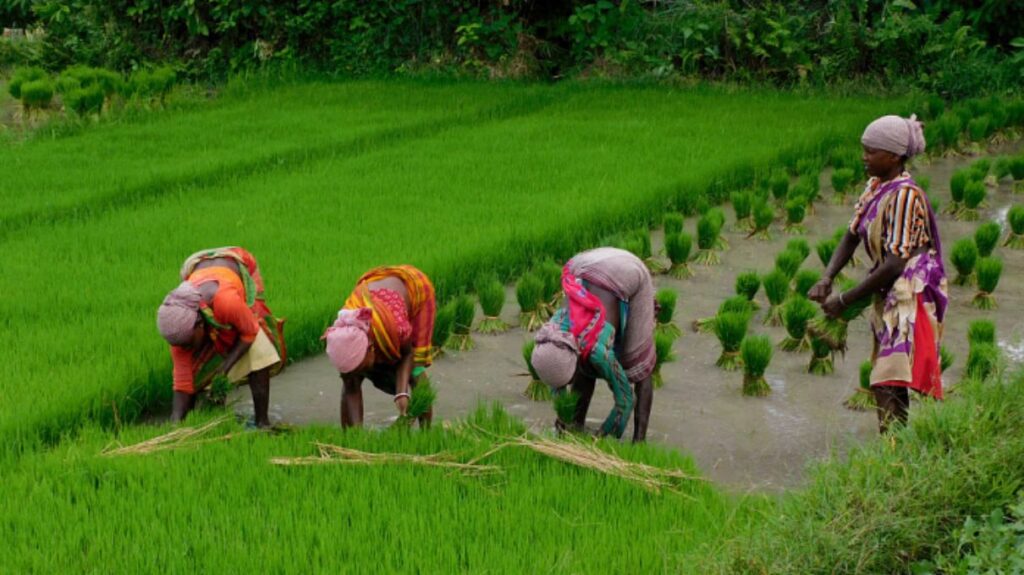
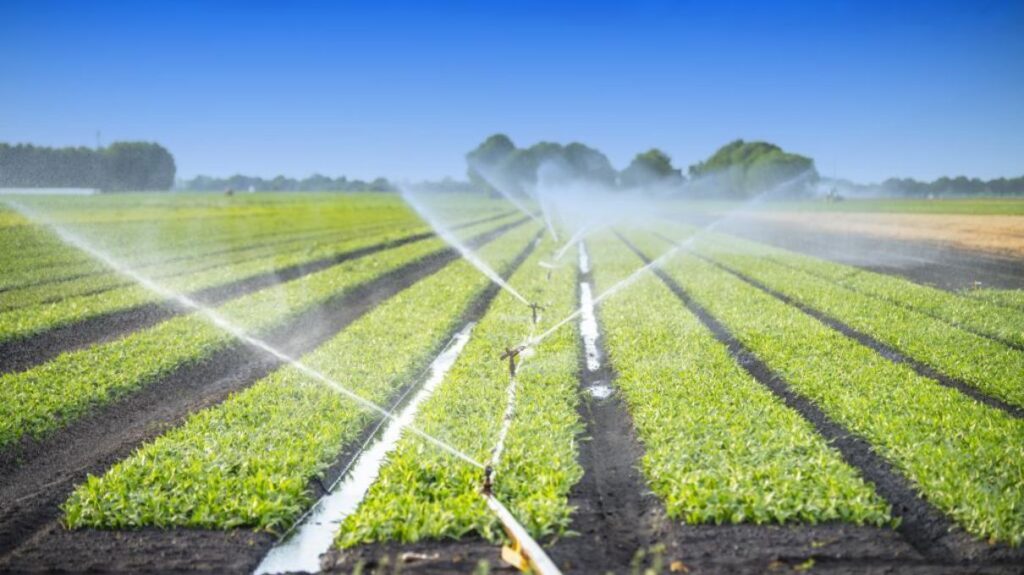
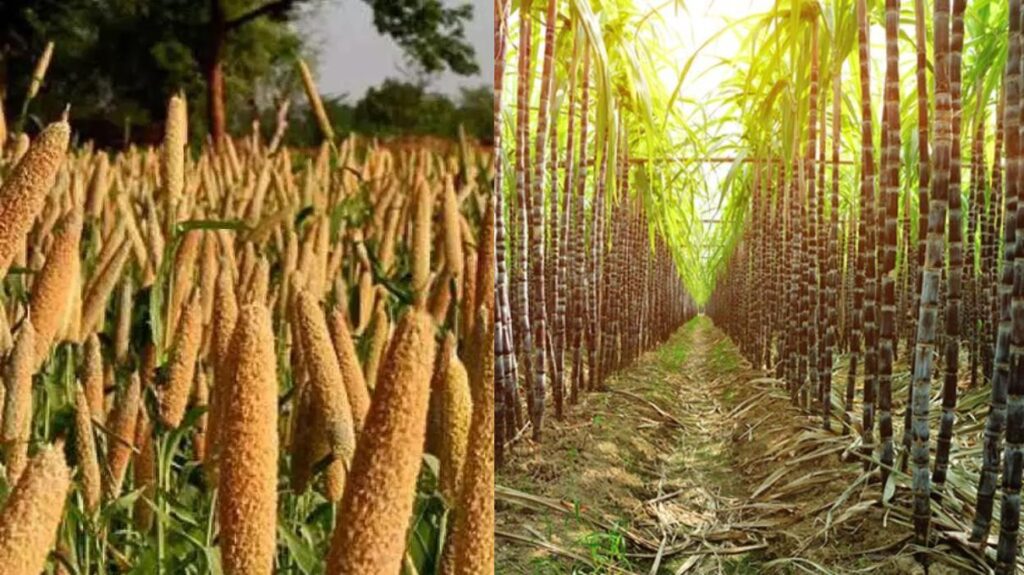
Rabi Crops (Winter Season)
- Wheat: Wheat is the dominant Rabi crop, showing minor fluctuations with a slight decline to 2,310.7 thousand tonnes in 2021-22 from a peak of 2,628 thousand tonnes in 2014-15.
- Gram: There has been a decline in gram production from 79 thousand tonnes in 2011-12 to 38.06 thousand tonnes in 2021-22, indicating reduced cultivation or market demand.
- Barley: Barley production has decreased substantially, from 41 thousand tonnes in 2011-12 to just 3.24 thousand tonnes in 2021-22.
- Rabi Pulses: Similar to Kharif pulses, Rabi pulses show fluctuating production, with 5.349 thousand tonnes in 2021-22.
- Summer Moong: This crop exhibits significant fluctuations, with a sharp rise in 2021-22 to 42.61 thousand tonnes, compared to the lower values in earlier years.
Total Rabi Foodgrains: The total production of Rabi foodgrains remains fairly stable over the years, showing a decrease to 2,399.959 thousand tonnes in 2021-22 from a high of 2,751 thousand tonnes in 2014-15.
Total Kharif and Rabi Foodgrains
The total combined food grain production for both Kharif and Rabi crops fluctuates but shows an overall decline in the later years, from 4,637 thousand tonnes in 2011-12 to 4,548.891 thousand tonnes in 2021-22.
Commercial Crops
- Sugarcane: Sugarcane production has seen minor fluctuations, maintaining a relatively stable level around 100 thousand tonnes throughout the period.
- Cotton: Cotton production has fluctuated between 593 thousand tonnes and 719.86 thousand tonnes, with a noticeable decline in recent years to 632.25 thousand tonnes in 2021-22.
- Guar: Guar production peaked at 481 thousand tonnes in 2013-14 but has decreased sharply to 113.057 thousand tonnes in 2021-22.
- Kharif Oilseeds: Oilseed production showed fluctuation, with a steady increase to 15.023 thousand tonnes in 2021-22.
- Rabi Oilseeds: Oilseeds, particularly Rabi oilseeds, have seen a notable increase, with production rising from 536 thousand tonnes in 2011-12 to 879.67 thousand tonnes in 2021-22.
- Sunflower: Sunflower production showed a significant rise in 2021-22, reaching 24.63 thousand tonnes, which is a substantial increase compared to previous years.
Total Oilseeds: The total oilseed production, including both Kharif and Rabi oilseeds, increased substantially to 919.323 thousand tonnes in 2021-22 from 546 thousand tonnes in 2011-12.
In 2015-2016, Haryana produced 13.35 million tonnes of wheat, 4.14 million tonnes of rice, and 7.17 million tonnes of sugarcane. Haryana also has a strong dairy industry, producing some of the best quality milk and supporting breeds like the Murrah buffalo. The state’s commitment to irrigation systems and the Bhakra Dam has made Haryana one of the most agriculturally self-sufficient states in India.
The state is also a significant producer of fruits, vegetables, and spices. Crops like potatoes, onions, and tomatoes are grown in abundance, alongside fruits like citrus and guava. Additionally, floriculture has seen growth, with flowers such as marigold and rose being cultivated on a large scale.
Livestock in Haryana
Haryana is renowned for its high-yielding livestock, particularly the Murrah buffalo, which is known for producing high-quality milk. The state also has indigenous cattle breeds like Haryanvi, Mewati, and Sahiwal, all of which are well-adapted to the local climate and contribute to both agricultural work and dairy farming.

The state’s commitment to dairying is evident in its contribution to India’s milk production, and buffalo milk is an essential part of the state’s agricultural economy. Haryana’s livestock sector is supported by robust veterinary care systems and policies to enhance productivity.
Research and Innovation in Haryana
Haryana has been an essential player in supporting agricultural advancements and industrial growth. Several key research institutes have been established in both the public and private sectors to address the state’s agrarian economy. Central research organizations such as the Central Institute for Research on Buffaloes, National Dairy Research Institute, and Indian Institute of Wheat and Barley Research work towards improving agricultural practices, livestock breeding, and food security. Additionally, state-supported institutions like Chaudhary Charan Singh Haryana Agricultural University (CCS HAU) and Lala Lajpat Rai University of Veterinary and Animal Sciences (LUVAS) contribute significantly to agricultural education and research, advancing techniques for better crop yield, animal husbandry, and veterinary care.


Haryana has emerged as one of India’s most industrialized states, particularly noted for its automobile, manufacturing, and electronics sectors. Faridabad, one of the largest industrial cities, is home to major multinational companies such as India Yamaha Motor Pvt. Ltd., Havells India Limited, and Larsen & Toubro . Panipat, known forouses oil refineries, urea plants, and a National Thermal Power Corporation power plant. These industrial hubs have made Haryana a vital contributor to the country’s manufacturing and production sectors.
Gurgaon is known for its significant IT and real estate industries. The city’s rapid urbanization and infrastructure development have attracted major global companies, including DLF Limited, one of India’s largest real estate developers. Gurgaon is also the home to several technology and service startups, further boosting Haryana’s economy .
Energy and Utilities
Haryana’s eneith a focus on sustainability and expansion. The state was a pioneer in rural electrification, achieving 100% rural electrification in 1970. Haryana is making strides in renewable energy, with solar power plants and hydroelectric stations contributing to the energy grid. The Gorakhpur Nuclear Power Plant, under construction, is set to add substantial capacity to the state’s power supply .
The state also operates several coal-fired thermal power statwing industrial and residential energy demands. Notably, the Indira Gandhi Super Thermal Power Project and Rajiv Gandhi Thermal Power Station play crucial roles in supplying electricity throughout the state.
Transport and Infrastructure
Haryana’s transport infrastructure is a backbone oic growth, especially in the NCR region. The state boasts an extensive road network, including national highways, state highways, and district roads. The Delhi-Agra Expressway and the Kundli-Manesar-Palwal Expressway enhance connectivity, while Haryana Roadways operates a large fleet of buses that serve millions daily.
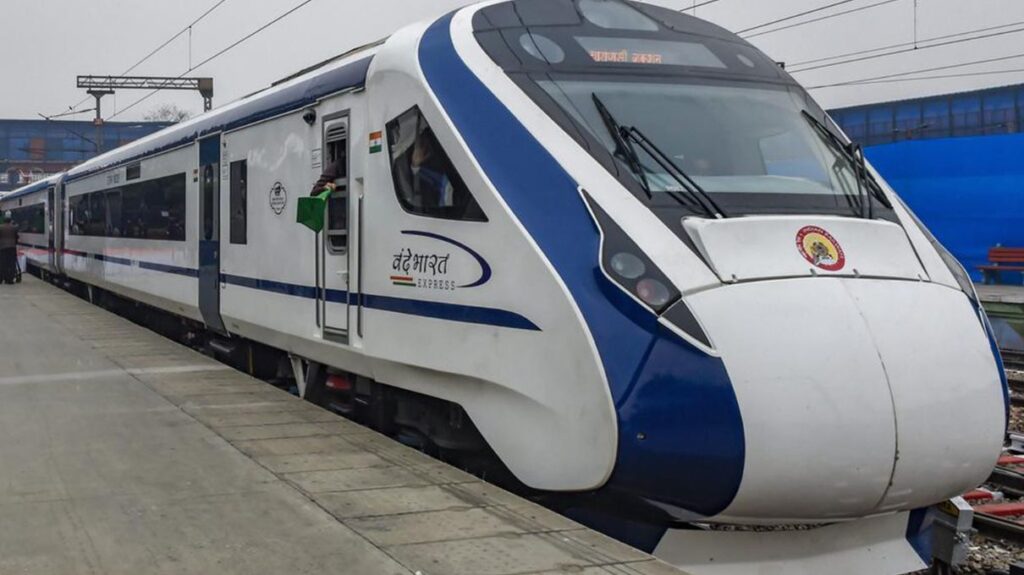


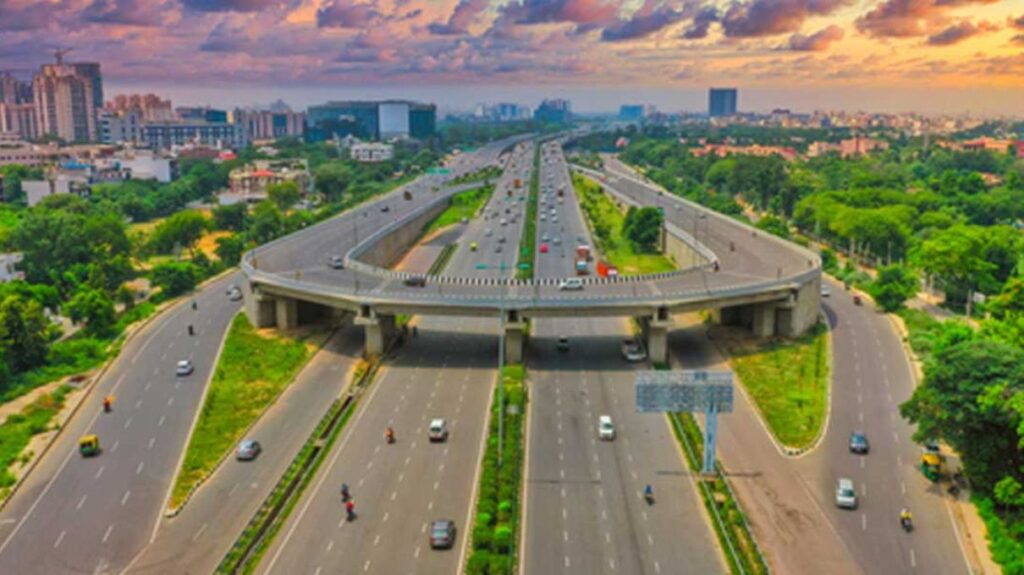
Railways in Haryana are managed by divisions under the North Western Railway and *Northern Rthe smooth movement of goods and passengers. Additionally, the ongoing development of the Diamond Quadrilateral High-speed rail network will bolster high-speed travel across the state .
Haryana is also part of the Delhi Metro network, with Metro stations in cities like Faridabad and Gurgaon, easing ving connectivity to the national capital .
Communication and Media
Haryana has a robust communication infrastructure, with an extensive telecommunication network and several medhat keep residents informed. The state operates its own Statewide Area Network (SWAN), which links government offices across the state for streamlined communication. Leading telecommunications companies like BSNL, Airtel, and Vodafone provide services throughout the state. Haryana also has a significant presa with popular news outlets such as Dainik Bhaskar, The Tribune, and Aaj Samaj printed and circulated in major cities.
Healthcare
Haryana has made notable advancements in healthcare, with an emphasis on improving maternal and child health outcomes. The state’s total fertility rate stands at 2.3, and while the infant mortality rate has shown a downward trend (41 per 1000 live births), there is still room for improvement in maternal health, with the maternal mortality ratio at 146 per 100,000 live births.
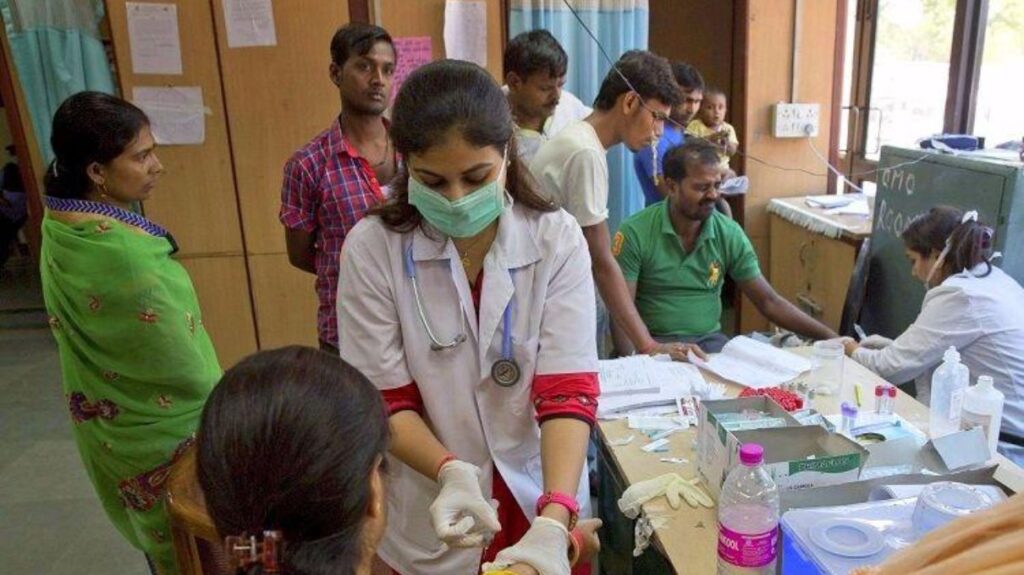

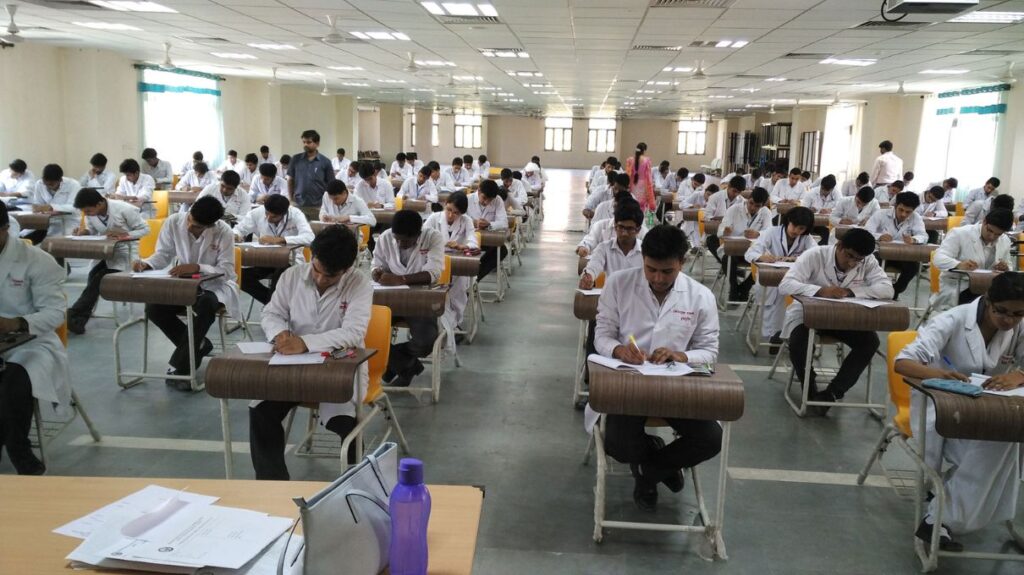
The state boasts several medical institutions, including prestigious public institutions like the Pandit Bhagwat Dayal Sharma Post Graduate Institute of Medical Sciences in Rohtak and private hospitals such as Medanta, Max Hospital, and Fortis Healthcare, making healthcare more accessible for both residents and people from neighboring regions. Additionally, Haryana’s government has partnered with national health programs like NRHM to improve the quality of healthcare and extend its reach to rural areas.
Education
Haryana has seen a significant rise in literacy over the past few decades. As of the 2011 Census, the state’s literacy rate is 76.64%, with a notable gender gap in education—male literacy at 85.38% compared to female literacy at 66.67%. The state’s urban areas, especially Gurgaon, Panchkula, and Ambala, are known for their high literacy rates. Gurgaon, for example, leads with an impressive literacy rate of 86.30%.
Schools and Universities
The Haryana Board of School Education (HBSE), established in 1969, oversees public examinations at various levels. The board also offers free education to women up to the bachelor’s degree level, contributing to an increase in female literacy. Haryana has nearly 20,000 schools, with a substantial number being government-funded. Additionally, there is a mix of government, private, and central schools such as Kendriya Vidyalayas and Jawahar Navodaya Vidyalayas.
In terms of higher education, Haryana is home to 48 universities, including Chaudhary Charan Singh Haryana Agricultural University (Hisar), which is Asia’s largest agricultural university, and Guru Jambheshwar University of Science and Technology. The state’s higher education institutions provide opportunities in various fields, ranging from agriculture to science and technology. The National Institute of Electronics and Information Technology (NIELIT) and the Software Technology Park of India (STPI) are significant additions to the state’s technology and education infrastructure.
Sports
Haryana has a rich sporting culture and has produced numerous world-class athletes. The state has a strong legacy in wrestling, cricket, boxing, and badminton, among others.
Wrestling
Wrestling is deeply rooted in Haryana’s cultural fabric. The state has produced many Olympic and World Championship medalists, including Sakshi Malik, who won a bronze medal at the 2016 Rio Olympics. Ravi Dahiya, from Sonipat, earned a silver medal in the 2020 Tokyo Olympics in freestyle wrestling. Another notable wrestler, Neeraj Chopra, from Panipat, became the first Indian to win a gold medal in Javelin Throw at the Tokyo Olympics.



Cricket and Other Sports
Haryana is also famous for its cricketing legacy, with Kapil Dev, the 1983 World Cup-winning captain, making his debut for Haryana. The state hosts several sporting events and has world-class facilities such as the Tau Devi Lal Stadium in Gurgaon and Tejli Sports Complex in Yamuna Nagar. The state’s sports policy, implemented in 2015, focuses on developing Haryana as India’s sports hub, supporting 26 Olympic sports.
In addition to wrestling and cricket, Haryana has made significant strides in badminton, with athletes like Saina Nehwal and K. Srikanth achieving international success. The state also supports professional teams like Haryana Gold in basketball and has a growing presence in other sports such as kabaddi and boxing.
Conclusion
Haryana stands as a thriving state, committed to enhancing its healthcare, education, and sports sectors. With a focus on building world-class medical facilities, a strong educational infrastructure, and nurturing sporting talent, Haryana continues to make notable contributions to India’s development across these domains. The state’s achievements in sports, particularly wrestling and athletics, and its efforts to foster a well-educated, healthy population, make it one of India’s key states in the modern era.
https://en.wikipedia.org/wiki/Haryana#Culture

